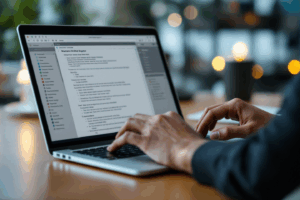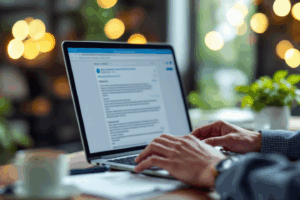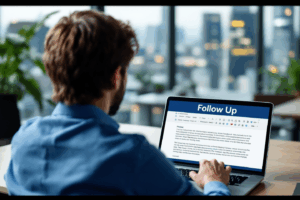
Present Simple Tense 1
English Blogs “Let’s Learn, Explore, and Connect to the World” Present Simple Tense 1 I. Introduction to the Present Simple Tense in English Mastering the


 In today’s digital-first business environment, emails have become the lifeline of professional communication, connecting colleagues, clients, and partners across the globe. In today’s professional world, writing strong business emails is no longer optional, it’s essential. Well-written emails ensure clear communication, foster professional relationships, and facilitate efficient business operations. Over previous discussions, we’ve laid a solid foundation by exploring key aspects of business email writing, including sentence structure & clarity, mechanics & punctuation, subject-verb agreement & tenses, and word choice & usage. These elements are essential for ensuring their recipients understand and take your emails seriously.
In today’s digital-first business environment, emails have become the lifeline of professional communication, connecting colleagues, clients, and partners across the globe. In today’s professional world, writing strong business emails is no longer optional, it’s essential. Well-written emails ensure clear communication, foster professional relationships, and facilitate efficient business operations. Over previous discussions, we’ve laid a solid foundation by exploring key aspects of business email writing, including sentence structure & clarity, mechanics & punctuation, subject-verb agreement & tenses, and word choice & usage. These elements are essential for ensuring their recipients understand and take your emails seriously.
 However, mastering business emails goes beyond these fundamental components. It requires understanding more nuanced aspects of communication, such as the email’s tone, structure, and etiquette surrounding email interactions. These additional tips focus on advanced strategies and etiquette that can significantly enhance the effectiveness of your email communication. From crafting concise and compelling messages to understanding the importance of cultural sensitivity, these strategies are designed to refine your email writing skills further.
However, mastering business emails goes beyond these fundamental components. It requires understanding more nuanced aspects of communication, such as the email’s tone, structure, and etiquette surrounding email interactions. These additional tips focus on advanced strategies and etiquette that can significantly enhance the effectiveness of your email communication. From crafting concise and compelling messages to understanding the importance of cultural sensitivity, these strategies are designed to refine your email writing skills further.
These are complex topics, but let’s keep it clear and to the point. We want to be respectful of everyone’s time and build good working relationships while we learn. By applying these additional tips, you’ll be better equipped to navigate the complexities of business communication, ensuring your emails not only reach the inbox but also resonate with the reader. Let’s embark on this journey to elevate your business email prowess, ensuring your messages stand out in a crowded inbox for all the right reasons.
 In the realm of business emails, the ability to communicate with precision and brevity is invaluable. This approach not only respects the recipient’s time but also ensures your message is understood with minimal effort. It can be challenging to write emails that are both short and clear, but that’s the key to getting your message across effectively.
In the realm of business emails, the ability to communicate with precision and brevity is invaluable. This approach not only respects the recipient’s time but also ensures your message is understood with minimal effort. It can be challenging to write emails that are both short and clear, but that’s the key to getting your message across effectively.
 Conciseness in email communication is about delivering your message in the fewest possible words without omitting essential information. This efficiency allows the recipient to quickly grasp your message’s essence, enhancing the likelihood of a prompt and appropriate response. However, brevity should not come at the expense of clarity. Every sentence should serve a purpose, whether it’s to convey a key point, provide necessary details, or prompt action. The goal is to eliminate unnecessary words while ensuring your message remains clear and your intent unambiguous.
Conciseness in email communication is about delivering your message in the fewest possible words without omitting essential information. This efficiency allows the recipient to quickly grasp your message’s essence, enhancing the likelihood of a prompt and appropriate response. However, brevity should not come at the expense of clarity. Every sentence should serve a purpose, whether it’s to convey a key point, provide necessary details, or prompt action. The goal is to eliminate unnecessary words while ensuring your message remains clear and your intent unambiguous.
 Eliminating redundancy and fluff is crucial for writing concise emails. Redundancy occurs when the same information is repeated unnecessarily, while fluff consists of words, phrases, or sentences that do not add value to the message. To combat these issues, start by scrutinizing each sentence for unnecessary repetitions and superfluous information. Phrases like “I am writing to inform you” can often be removed, as the act of sending the email already implies this. Active voice gets straight to the point and uses fewer words, making your writing clear and easy to read. For instance, “The meeting was scheduled by the team” can be more succinctly expressed as “The team scheduled the meeting.”
Eliminating redundancy and fluff is crucial for writing concise emails. Redundancy occurs when the same information is repeated unnecessarily, while fluff consists of words, phrases, or sentences that do not add value to the message. To combat these issues, start by scrutinizing each sentence for unnecessary repetitions and superfluous information. Phrases like “I am writing to inform you” can often be removed, as the act of sending the email already implies this. Active voice gets straight to the point and uses fewer words, making your writing clear and easy to read. For instance, “The meeting was scheduled by the team” can be more succinctly expressed as “The team scheduled the meeting.”
Another effective technique is to avoid over-elaboration. Provide enough detail to convey your message clearly but resist the urge to include irrelevant information. This approach helps in maintaining focus and ensures that the key points stand out.
 The bullet points and numbered lists are excellent tools for enhancing clarity and conciseness in emails. They allow you to present information in an organized manner, making it easier for the recipient to scan and understand key points quickly. When listing items, actions, or key points, bullet points can highlight each element distinctly, drawing attention to important details without getting lost in lengthy paragraphs.
The bullet points and numbered lists are excellent tools for enhancing clarity and conciseness in emails. They allow you to present information in an organized manner, making it easier for the recipient to scan and understand key points quickly. When listing items, actions, or key points, bullet points can highlight each element distinctly, drawing attention to important details without getting lost in lengthy paragraphs.
 Numbered lists are particularly useful when outlining steps, instructions, or reasons. They provide a clear structure that guides the reader through your content sequentially, ensuring that complex information is digestible and actionable. Additionally, using lists can break up large blocks of text, making your email more visually appealing and less daunting to read.
Numbered lists are particularly useful when outlining steps, instructions, or reasons. They provide a clear structure that guides the reader through your content sequentially, ensuring that complex information is digestible and actionable. Additionally, using lists can break up large blocks of text, making your email more visually appealing and less daunting to read.
The art of precision and brevity in business emails is a skill that develops over time and with practice. By focusing on being concise without sacrificing clarity, employing techniques to eliminate redundancy, and effectively using bullet points and numbered lists, you can craft emails that communicate your message effectively and efficiently. This approach not only enhances the readability of your emails but also demonstrates respect for your recipient’s time, contributing to more productive and positive professional relationships.
 The way you write your business emails can make a big difference in how your message is understood and whether you achieve your goal. It’s the subtleties in language that can convey respect, establish rapport, and demonstrate professionalism. Similarly, politeness is not just a matter of etiquette; it’s essential for fostering positive relationships and ensuring your emails are received in the best possible light. This section explores how to adjust the tone to suit the purpose of your email and the recipient, strategies for ensuring politeness and respect, and the importance of cultural sensitivity.
The way you write your business emails can make a big difference in how your message is understood and whether you achieve your goal. It’s the subtleties in language that can convey respect, establish rapport, and demonstrate professionalism. Similarly, politeness is not just a matter of etiquette; it’s essential for fostering positive relationships and ensuring your emails are received in the best possible light. This section explores how to adjust the tone to suit the purpose of your email and the recipient, strategies for ensuring politeness and respect, and the importance of cultural sensitivity.
 The tone of your email should be tailored to both its purpose and the recipient. A message to a long-time colleague can afford to be more casual and warm, whereas an email to a new client or senior executive should be more formal and reserved. Identifying the purpose of your email is the first step—whether it’s to inform, request, apologize, or persuade. This purpose should guide your tone, ensuring it’s appropriate and effective. For instance, a persuasive email might adopt a confident yet respectful tone, while an informational email would be straightforward and professional.
The tone of your email should be tailored to both its purpose and the recipient. A message to a long-time colleague can afford to be more casual and warm, whereas an email to a new client or senior executive should be more formal and reserved. Identifying the purpose of your email is the first step—whether it’s to inform, request, apologize, or persuade. This purpose should guide your tone, ensuring it’s appropriate and effective. For instance, a persuasive email might adopt a confident yet respectful tone, while an informational email would be straightforward and professional.
 Politeness in emails is conveyed through word choice, sentence structure, and overall language use. Taking a moment to be polite with “please” and “thank you” demonstrates respect and appreciation for the recipient’s time and attention. This small gesture can significantly improve the overall tone of your email. Similarly, acknowledging the recipient’s time and effort, such as starting with “Thank you for your prompt response” or “I appreciate the time you’ve taken,” sets a respectful and considerate tone.
Politeness in emails is conveyed through word choice, sentence structure, and overall language use. Taking a moment to be polite with “please” and “thank you” demonstrates respect and appreciation for the recipient’s time and attention. This small gesture can significantly improve the overall tone of your email. Similarly, acknowledging the recipient’s time and effort, such as starting with “Thank you for your prompt response” or “I appreciate the time you’ve taken,” sets a respectful and considerate tone.
Avoiding imperatives can also make requests sound more polite. Instead of “Send me the report by Monday,” consider “Could you please send me the report by Monday?” This minor adjustment can significantly impact the email’s tone, making it sound less like a demand and more like a respectful request.
 Cultural sensitivity is crucial in international business communications. Different cultures have varying norms and expectations regarding formality, directness, and etiquette. For example, some cultures value a highly formal approach with titles and surnames, while others may prefer first-name basis interactions even in professional settings. Researching and understanding these cultural nuances can prevent misunderstandings and foster more effective communication. Additionally, being mindful of holidays, work hours, and significant cultural events in the recipient’s country can further demonstrate respect and cultural awareness.
Cultural sensitivity is crucial in international business communications. Different cultures have varying norms and expectations regarding formality, directness, and etiquette. For example, some cultures value a highly formal approach with titles and surnames, while others may prefer first-name basis interactions even in professional settings. Researching and understanding these cultural nuances can prevent misunderstandings and foster more effective communication. Additionally, being mindful of holidays, work hours, and significant cultural events in the recipient’s country can further demonstrate respect and cultural awareness.
In summary, the tone and politeness of your business emails are fundamental to successful communication. By adjusting your tone, employing strategies to ensure politeness, and being culturally sensitive, you can build positive relationships, avoid misunderstandings, and convey your messages more effectively.
 The structure and organization of your business emails are just as critical as the content itself. Proper organization ensures your message is easily digestible, clearly understood, and actionable. This section delves into advanced formatting tips for enhancing readability, effective structuring for easy navigation, and the pivotal role of a compelling opening and a clear call-to-action (CTA) in your emails.
The structure and organization of your business emails are just as critical as the content itself. Proper organization ensures your message is easily digestible, clearly understood, and actionable. This section delves into advanced formatting tips for enhancing readability, effective structuring for easy navigation, and the pivotal role of a compelling opening and a clear call-to-action (CTA) in your emails.
 Readability is paramount in business emails, where time is often at a premium. Break up your emails with clear headings and subheadings to make them easier to read and find important information. Bold or italicize keywords or phrases to emphasize crucial information without overwhelming the reader. However, use these sparingly to maintain their impact. Short paragraphs and white space are your allies; they prevent your email from appearing as an intimidating text block, making it more approachable and easier to scan.
Readability is paramount in business emails, where time is often at a premium. Break up your emails with clear headings and subheadings to make them easier to read and find important information. Bold or italicize keywords or phrases to emphasize crucial information without overwhelming the reader. However, use these sparingly to maintain their impact. Short paragraphs and white space are your allies; they prevent your email from appearing as an intimidating text block, making it more approachable and easier to scan.
 The structure of your email should guide the reader through your message in a coherent and logical manner. Begin with a clear introduction that sets the context and purpose of the email. This could be a brief summary of the situation, a reference to a previous communication, or an introduction to the topic at hand.
The structure of your email should guide the reader through your message in a coherent and logical manner. Begin with a clear introduction that sets the context and purpose of the email. This could be a brief summary of the situation, a reference to a previous communication, or an introduction to the topic at hand.
Follow this with the body of your email, where the bulk of your information or request is detailed. If you’re covering multiple points, consider listing them using bullet points, or you can use numbered lists to break the information down into manageable parts. This not only aids in readability but also helps in ensuring that none of your points are overlooked.
End with a conclusion that succinctly wraps up your email, reiterating any important actions needed or summarizing the key points discussed. This reinforces your message and ensures clarity.
 Your email’s opening should grab the recipient’s attention and encourage them to read on. It should be relevant, engaging, and convey the value of your message. The opening lines set the tone for the rest of the email, so make them count.
Your email’s opening should grab the recipient’s attention and encourage them to read on. It should be relevant, engaging, and convey the value of your message. The opening lines set the tone for the rest of the email, so make them count.
Equally important is your closing, which should include a clear call-to-action (CTA). Be explicit about what you want the recipient to do next—whether it’s to reply with specific information, complete a task, or confirm their attendance at a meeting. A clear CTA removes any ambiguity about the expected response, increasing the likelihood of the desired action being taken.
Mastering the art of email structure and organization not only enhances the readability of your messages but also ensures they are effective and action-oriented. By paying attention to formatting, structuring your content for easy navigation, and crafting compelling openings and clear CTAs, your emails will stand out for their clarity and persuasiveness, making every word count.
 The subject line is your chance to grab the reader’s attention and get them to open your email. A good one can mean the difference between getting read right away or lost in their inbox. An effective subject line serves as a headline, succinctly conveying the essence of your message while enticing the recipient to read further. This section explores the art of crafting informative and attention-grabbing subject lines, common pitfalls to avoid, and strategies for using the subject line to signify the importance of your email.
The subject line is your chance to grab the reader’s attention and get them to open your email. A good one can mean the difference between getting read right away or lost in their inbox. An effective subject line serves as a headline, succinctly conveying the essence of your message while enticing the recipient to read further. This section explores the art of crafting informative and attention-grabbing subject lines, common pitfalls to avoid, and strategies for using the subject line to signify the importance of your email.
 A compelling subject line strikes a balance between being informative and engaging. It should give the recipient a clear idea of what the email is about while sparking curiosity or highlighting urgency. For instance, instead of a generic “Meeting Update,” a more effective subject line could be “New Meeting Date: Action Required by Friday.” This not only informs the recipient of a meeting update but also signals that their input or action is needed, adding a sense of urgency.
A compelling subject line strikes a balance between being informative and engaging. It should give the recipient a clear idea of what the email is about while sparking curiosity or highlighting urgency. For instance, instead of a generic “Meeting Update,” a more effective subject line could be “New Meeting Date: Action Required by Friday.” This not only informs the recipient of a meeting update but also signals that their input or action is needed, adding a sense of urgency.
Personalization can also enhance the impact of your subject line. Including the recipient’s name or a reference to a recent interaction can make the email feel more tailored and relevant, increasing the chances of it being opened.
 One common mistake is leaving the subject line vague or, worse, empty. This can lead to your email being overlooked or marked as spam. Overusing caps lock or exclamation points can also work against you, making your email appear unprofessional or even aggressive. Additionally, misleading subject lines that don’t match the email’s content can frustrate recipients and damage trust.
One common mistake is leaving the subject line vague or, worse, empty. This can lead to your email being overlooked or marked as spam. Overusing caps lock or exclamation points can also work against you, making your email appear unprofessional or even aggressive. Additionally, misleading subject lines that don’t match the email’s content can frustrate recipients and damage trust.
Another pitfall is making the subject line too long. With many people checking emails on mobile devices, lengthy subject lines can get cut off, losing their effectiveness. Aim for brevity, with a sweet spot of 6 to 10 words being ideal for most email clients.
 The subject line can also indicate the priority or urgency of your email. Phrases like “Immediate Action Required,” “For Your Review,” or “Deadline Extended” clearly communicate the importance of the email and the type of response needed. However, use these cues judiciously to avoid diluting their impact over time.
The subject line can also indicate the priority or urgency of your email. Phrases like “Immediate Action Required,” “For Your Review,” or “Deadline Extended” clearly communicate the importance of the email and the type of response needed. However, use these cues judiciously to avoid diluting their impact over time.
For non-urgent emails that still require attention, indicating a timeframe can be helpful, such as “Please Review by Next Week.” This helps the recipient prioritize their response without feeling undue pressure.
The subject line is a crucial element of effective email communication, serving as the gateway to your message. By crafting subject lines that are both informative and engaging, avoiding common mistakes, and using them to indicate urgency appropriately, you can significantly increase the visibility and impact of your emails.
 Navigating follow-up emails and managing long email threads are vital skills in professional communication. The way you write follow-up emails, whether for a request, meeting, or anything else, can make a big difference in how well they work. Similarly, maintaining clarity and courtesy in long email threads or when altering the recipient list is crucial for smooth, professional interactions. This section will delve into the best practices for follow-up emails, strategies for managing lengthy email threads, and the etiquette of modifying the recipient list.
Navigating follow-up emails and managing long email threads are vital skills in professional communication. The way you write follow-up emails, whether for a request, meeting, or anything else, can make a big difference in how well they work. Similarly, maintaining clarity and courtesy in long email threads or when altering the recipient list is crucial for smooth, professional interactions. This section will delve into the best practices for follow-up emails, strategies for managing lengthy email threads, and the etiquette of modifying the recipient list.
 Follow-up emails are essential for keeping projects on track and ensuring your initial message doesn’t go unnoticed. When crafting a follow-up, start by providing context. A brief mention of your previous email and its date can help jog the recipient’s memory. Be polite yet assertive, clearly stating the action you’re seeking without implying negligence. For example, “I wanted to follow up on my email from last Thursday about the quarterly report. Could you please let me know the status of your review?”
Follow-up emails are essential for keeping projects on track and ensuring your initial message doesn’t go unnoticed. When crafting a follow-up, start by providing context. A brief mention of your previous email and its date can help jog the recipient’s memory. Be polite yet assertive, clearly stating the action you’re seeking without implying negligence. For example, “I wanted to follow up on my email from last Thursday about the quarterly report. Could you please let me know the status of your review?”
Timing is also crucial; allow enough time between your initial email and the follow-up to give the recipient a chance to respond, typically a few days to a week, depending on the urgency.
 Long email threads can become confusing, especially when the subject veers off from the original topic. To keep the conversation clear, consider starting a new thread with a summarized update or conclusion of the previous discussion when shifting to a new but related topic. This keeps the email focused and accessible to those who might have been added to the conversation later.
Long email threads can become confusing, especially when the subject veers off from the original topic. To keep the conversation clear, consider starting a new thread with a summarized update or conclusion of the previous discussion when shifting to a new but related topic. This keeps the email focused and accessible to those who might have been added to the conversation later.
Ensure the subject line remains relevant to the thread’s current focus. If the discussion’s direction changes significantly, update the subject line accordingly to reflect the new focus.
 When adding someone to an ongoing email thread, it’s polite to introduce the new recipient at the beginning of your email, explaining why they’ve been added. This not only informs the original recipients but also helps the new add-on to understand the context. For example, “I’ve added John Doe to this conversation as he will be leading the project moving forward.”
When adding someone to an ongoing email thread, it’s polite to introduce the new recipient at the beginning of your email, explaining why they’ve been added. This not only informs the original recipients but also helps the new add-on to understand the context. For example, “I’ve added John Doe to this conversation as he will be leading the project moving forward.”
Similarly, if removing someone from an email chain, consider sending them a brief note explaining why they’re being removed, ensuring they don’t feel abruptly cut off. This can often be done in a separate email to maintain their privacy.
By adhering to these best practices for follow-up emails, effectively managing long email threads, and observing proper etiquette when changing the recipient list, you can maintain professionalism, ensure clarity, and foster positive working relationships in your email communications.
 Mastering the art of business email communication is an ongoing journey that extends far beyond understanding the basics of grammar and punctuation. As we have explored in this article, numerous nuances and advanced strategies can significantly enhance your email’s effectiveness. From the art of precision and brevity, ensuring your messages are concise yet clear, to the delicate balance of tone and politeness, which can greatly influence how your messages are received. We’ve delved into the importance of a well-structured email, the critical role of a compelling subject line, and the best practices for managing follow-ups and email threads.
Mastering the art of business email communication is an ongoing journey that extends far beyond understanding the basics of grammar and punctuation. As we have explored in this article, numerous nuances and advanced strategies can significantly enhance your email’s effectiveness. From the art of precision and brevity, ensuring your messages are concise yet clear, to the delicate balance of tone and politeness, which can greatly influence how your messages are received. We’ve delved into the importance of a well-structured email, the critical role of a compelling subject line, and the best practices for managing follow-ups and email threads.
These additional tips are designed to refine your email communication skills further, ensuring that every email you send is impactful, respectful, and purposeful. The importance of continuous improvement in this area cannot be overstated; as our professional environment evolves, so too must our approach to communication.
 We encourage you to not only apply these strategies to your own email practices but also to share your experiences. Whether you’ve found success with a particularly compelling subject line, navigated a complex email thread with ease, or discovered a new approach to follow-up emails, your insights can benefit others. By sharing our experiences, we contribute to a community of professionals who value effective communication as a cornerstone of success.
We encourage you to not only apply these strategies to your own email practices but also to share your experiences. Whether you’ve found success with a particularly compelling subject line, navigated a complex email thread with ease, or discovered a new approach to follow-up emails, your insights can benefit others. By sharing our experiences, we contribute to a community of professionals who value effective communication as a cornerstone of success.
As you move forward, remember that each email is an opportunity to practice and perfect these skills. With every message sent, you are building stronger connections, enhancing your professional image, and paving the way for successful outcomes.

English Blogs “Let’s Learn, Explore, and Connect to the World” Present Simple Tense 1 I. Introduction to the Present Simple Tense in English Mastering the

English Blogs “Let’s Learn, Explore, and Connect to the World” Present Simple Tense 2 II. Understanding the Present Simple Tense Definition and Structure At its
Explore the world confidently with ‘Travel English’ by Allison Kate, a comic-style guide full of essential conversations and tips for every traveler. Speak English with ease in airports, hotels, and more!



